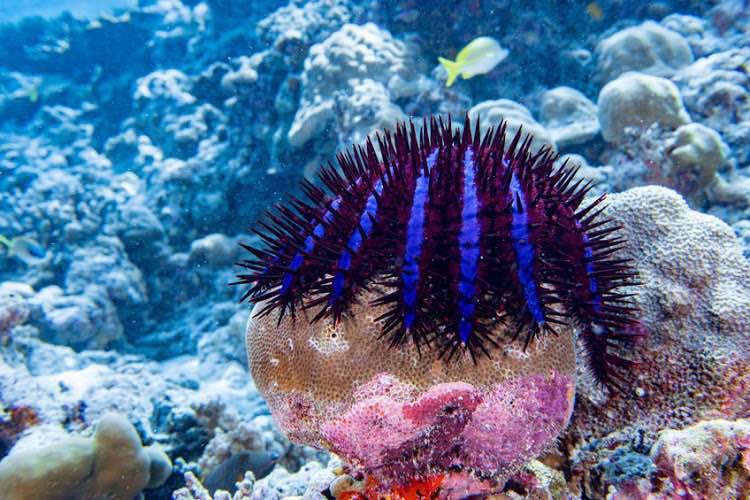
Thousands of crown-of-thorns starfish are understood to be eating their way through coral in a major outbreak at the southern end of the Great Barrier Reef, as authorities consider how to tackle the problem.
The predator starfish feeds on corals by spreading its stomach over them and using digestive enzymes to liquefy tissue, and the outbreak hits as the reef is still reeling from two consecutive years of major coral bleaching.
“Each starfish eats about its body diameter a night, and so over time that mounts up very significantly,” Hugh Sweatman, a senior research scientist at the Australian Institute of Marine Science told Australian Broadcasting Corporation (ABC) radio.
“A lot of coral will be lost,” he said.
That would mean a blow for both the ecosystem and the lucrative tourism industry which it supports.
The crown of thorns were found in plague proportions last month in the Swains Reefs, at the southern edge of the Great Barrier Reef, by researchers from the reef’s Marine Park Authority, a spokeswoman for the authority told Reuters by phone.
The remote reefs, about 200km offshore from Yeppoon, a holiday and fishing town some 500km north of Queensland state capital, Brisbane, are well south of the most-visited sections of the Great Barrier Reef, where most culling efforts are focused.
But the government’s Great Barrier Reef Marine Park Authority already killed some starfish at Swains Reefs in December and will mount another mission this month, a director at the authority, Fred Nucifora, told the ABC.
“The complexity with the Swains Reef location is … they are logistically difficult to access and it is actually quite a hostile environment to work in,” Nucifora said.
There have been four major crown of thorns outbreaks since the 1960s in the Great Barrier Reef but it recovered each time because there were always healthy populations of herbivorous fish. The outbreaks are usually triggered by extra nutrients in the water but the reason for the current outbreak was unclear, Sweatman said.
The reef is still recovering from damage wrought by the worst-ever coral bleaching on record, which in 2016 killed two-thirds of a 700km stretch of reef.
On Friday a report published in the journal Science found that high ocean temperatures are harming tropical corals much more often than a generation ago, putting reefs under pressure.
The Great Barrier Reef, covering 348,000 square kilometres, was world heritage listed in 1981 as the most extensive and spectacular coral reef ecosystem on the planet, according to the UNESCO website.
High ocean temperatures are harming tropical corals almost five times more often than in the 1980s, undermining reefs’ ability to survive marine heat waves caused by man-made climate change, scientists said on Thursday.
The average time between severe “bleachings”, when heat makes the stony-bodied creatures that make up coral reefs expel colourful algae, shortened to six years in 2016 from 25-30 years in the early 1980s, the Australian-led team wrote.
Corals die if bleachings are long-lasting, wrecking reefs that are nurseries for fish, a source of food to millions of people and a destination for scuba-diving tourists.
“Tropical reef systems are transitioning to a new era in which the interval between recurrent bouts of coral bleaching is too short for a full recovery” of mature corals that can require 10-15 years, the researchers wrote in the journal Science.
Climate change will “inevitably” make underwater heat waves and bleachings more frequent, they wrote.
The worst bleaching was in 2015-16, when record ocean temperatures affected 75% of 100 reefs studied from Australia’s Great Barrier Reef to the Caribbean.
Lead author Professor Terry Hughes, director of the ARC Centre of Excellence for Coral Reef Studies in Australia, urged more action to limit greenhouse gas emissions under the global 2015 Paris climate agreement.
The main problem for protecting reefs was “weak commitments for reductions in emissions from individual countries like Australia and the US,” he told Reuters in an e-mail.
US President Donald Trump, who doubts climate change is man-made, plans to pull out of the Paris accord and instead promote US fossil fuels. Australia’s goals under the Paris accord are less ambitious than those of some other rich nations.
The Paris pact seeks to limit a rise in average global surface temperatures to “well below” two degrees Celsius (3.6 Fahrenheit) above pre-industrial times, ideally 1.5degC by shifting from fossil fuels.
Corals are already under threat with warming of 1degC so far, a UN panel of climate scientists says.
In the 1980s, bleachings happened during local heat waves, and then started to occur in the 1980s and 1990s during natural El Nino weather events that release heat from the Pacific Ocean.
“Now we’re seeing the emergence of bleaching in every hot summer,” said Mark Eakin, an author of the study at the US National Oceanic & Atmospheric Administration, said in a statement.
Hughes said there was evidence that some corals could adapt to rising temperatures. The Great Barrier Reef, the world’s biggest, was not doomed if governments stepped up action.
“If the … Paris Agreement is successful we will still have a Great Barrier Reef. It will have a different mix of coral species, but it will still function and look like a reef,” he said.














This is not a new phenomena. Crown of Thorns Starfish are a threat to reefs from time to time. I believe there is a type of Prawn that can kill the starfish?